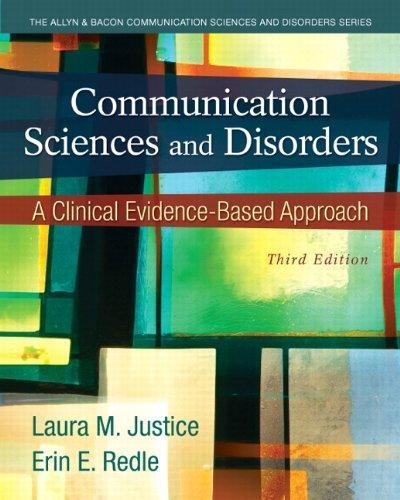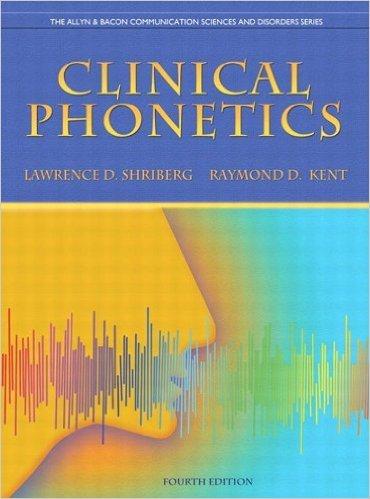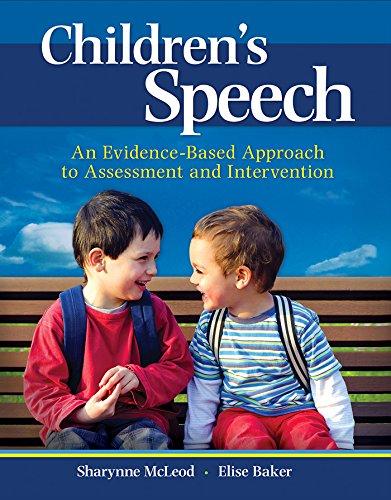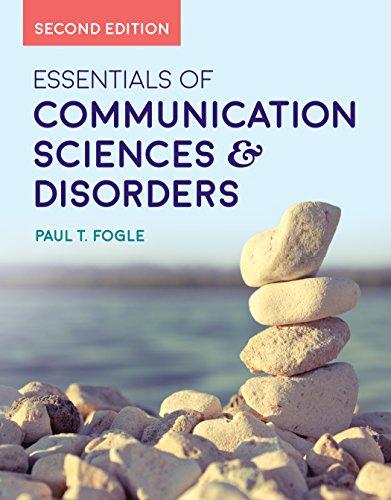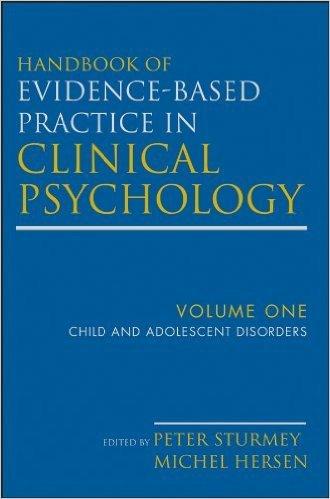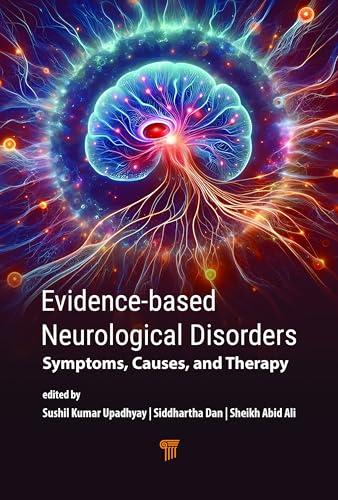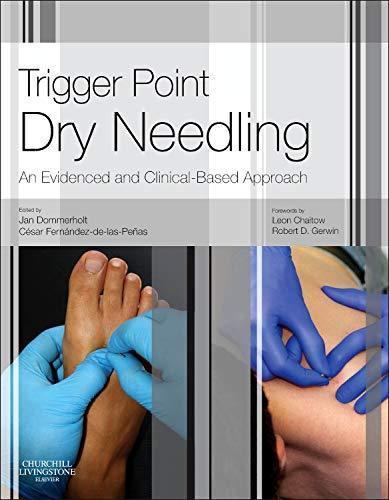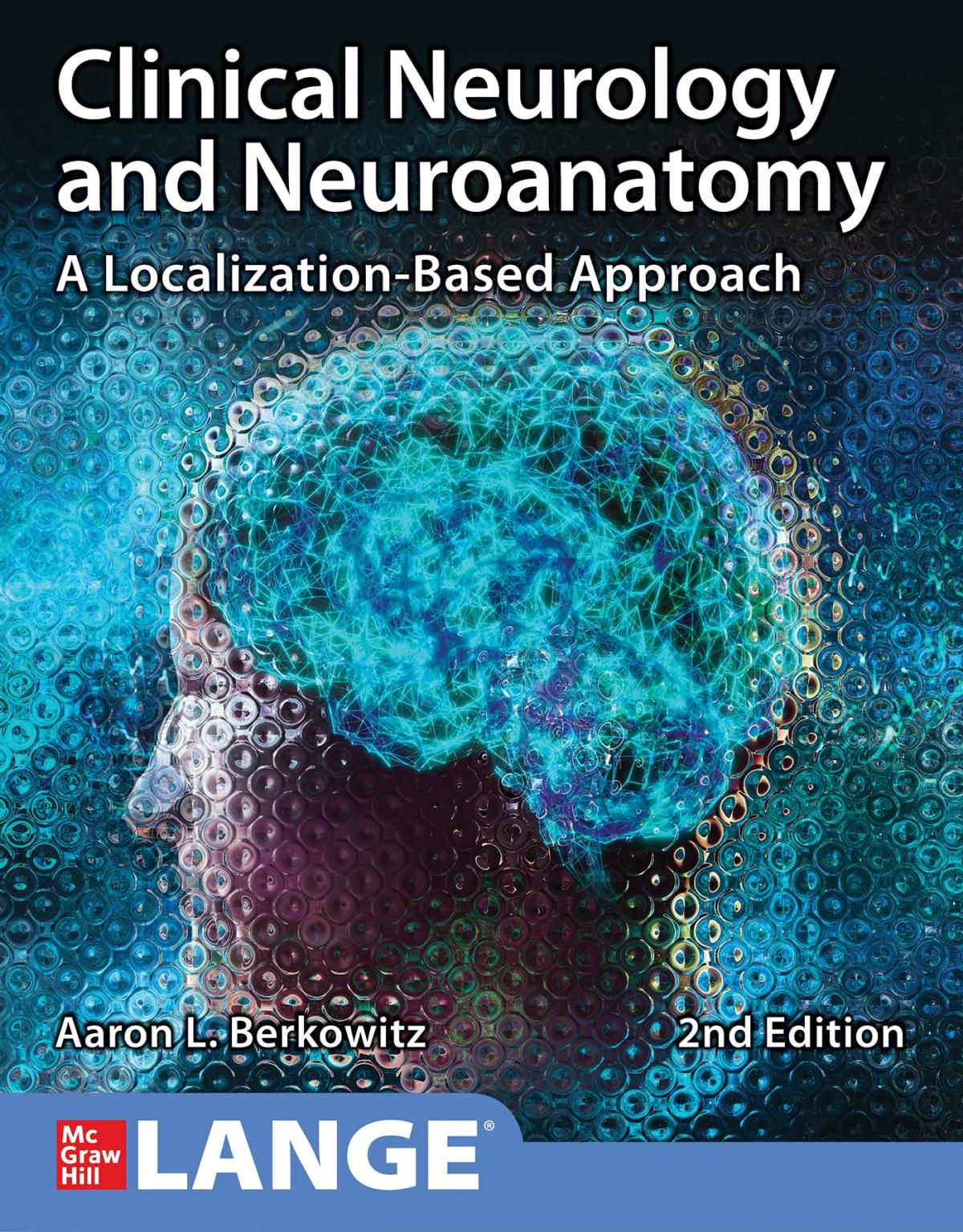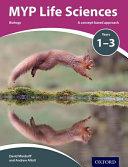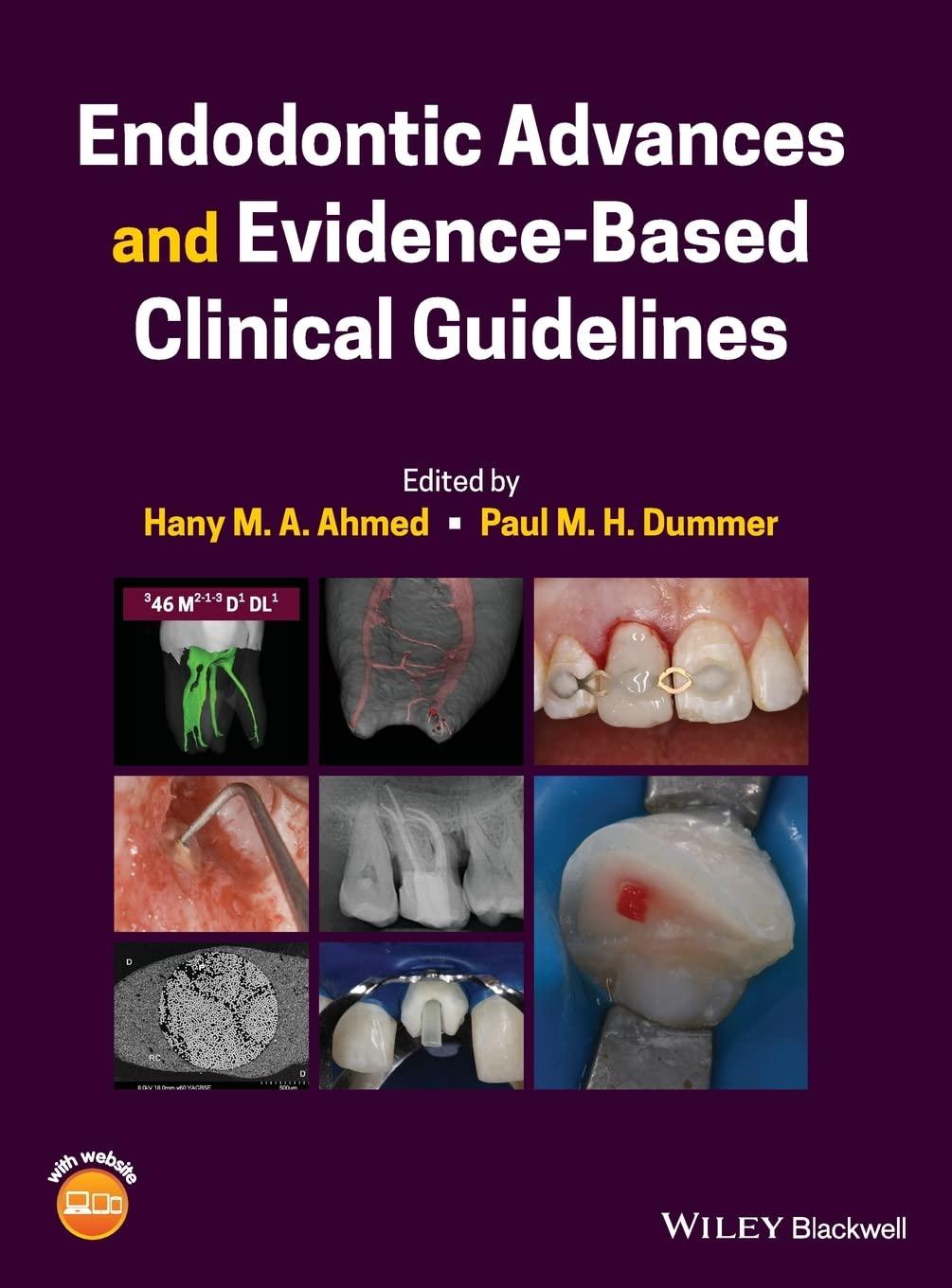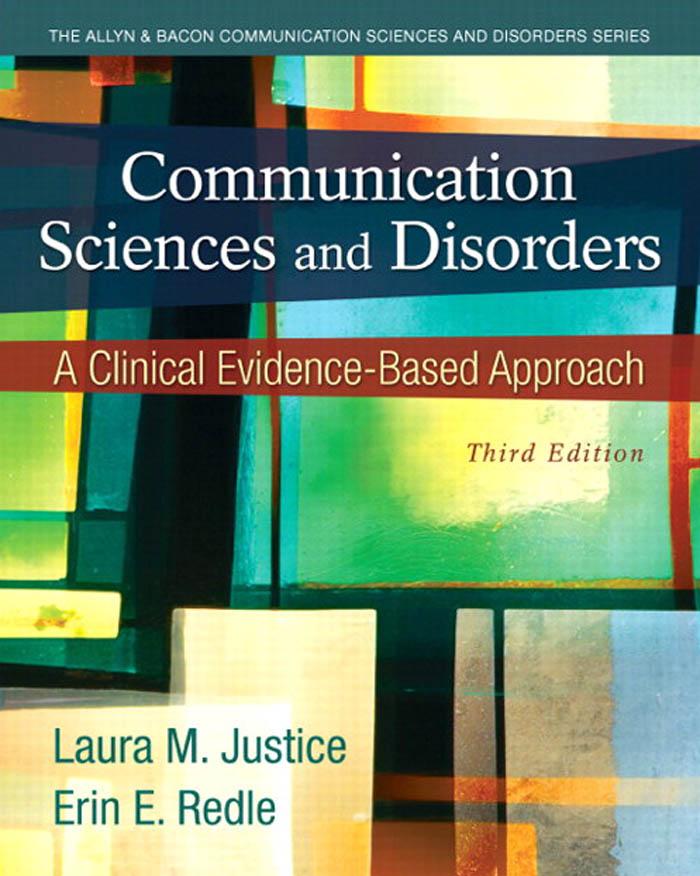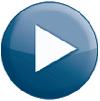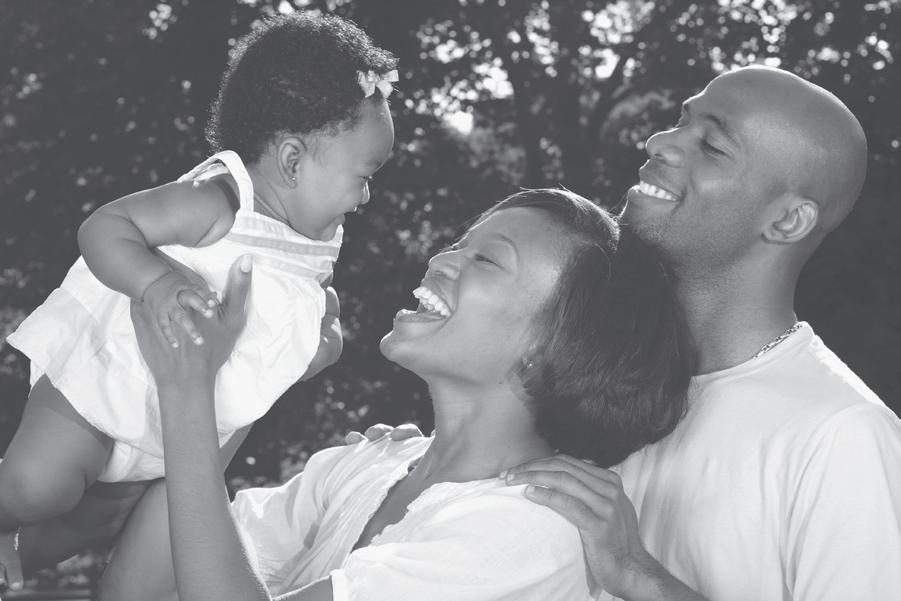Sciences and Disorders: A Clinical Evidence-Based Approach
Visit to download the full and correct content document: https://ebookmass.com/product/communication-sciences-and-disorders-a-clinical-evid ence-based-approach/
More products digital (pdf, epub, mobi) instant download maybe you interests ...
eTextbook 978-0137021062 Clinical Phonetics (The Allyn & Bacon Communication Sciences and Disorders Series)
https://ebookmass.com/product/etextbook-978-0137021062-clinicalphonetics-the-allyn-bacon-communication-sciences-and-disordersseries/
Children’s Speech: An Evidence Based Approach to Assessment and Intervention (What’s New in Communication Sciences & Diaorders) 1st Edition, (Ebook PDF)
https://ebookmass.com/product/childrens-speech-an-evidence-basedapproach-to-assessment-and-intervention-whats-new-incommunication-sciences-diaorders-1st-edition-ebook-pdf/
Essentials of Communication Sciences & Disorders 2nd Edition, (Ebook PDF)
https://ebookmass.com/product/essentials-of-communicationsciences-disorders-2nd-edition-ebook-pdf/
eTextbook 978-0470335444 Handbook of Evidence-Based Practice in Clinical Psychology, Child and Adolescent Disorders: Volume 1
https://ebookmass.com/product/etextbook-978-0470335444-handbookof-evidence-based-practice-in-clinical-psychology-child-andadolescent-disorders-volume-1/
Evidence■Based Neurological Disorders-Symptoms, Causes, and Therapy 1st Edition Upadhyay
https://ebookmass.com/product/evidence%e2%80%90basedneurological-disorders-symptoms-causes-and-therapy-1st-editionupadhyay/
Trigger Point Dry Needling: An Evidence and ClinicalBased Approach 1st Edition – Ebook PDF Version
https://ebookmass.com/product/trigger-point-dry-needling-anevidence-and-clinical-based-approach-1st-edition-ebook-pdfversion/
Clinical Neurology and Neuroanatomy: A LocalizationBased Approach 2nd Edition Aaron L. Berkowitz
https://ebookmass.com/product/clinical-neurology-andneuroanatomy-a-localization-based-approach-2nd-edition-aaron-lberkowitz/
MYP Life Sciences: a Concept Based Approach (IB MYP SERIES) Mindorff
https://ebookmass.com/product/myp-life-sciences-a-concept-basedapproach-ib-myp-series-mindorff/
Endodontic Advances and Evidence-Based Clinical Guidelines 1st Edition Hany M. A. Ahmed
https://ebookmass.com/product/endodontic-advances-and-evidencebased-clinical-guidelines-1st-edition-hany-m-a-ahmed/
3 Anatomical and Physiological Bases of Communication
and Communication Disorders 82
Introduction 83
What Body Structures Are Involved in Human Communication? 85
Terminology 85 • The Nervous System 85
How Do We Produce Speech? 96
Respiration 96 • Phonation 98 • Articulation 103
How Do We Hear? 104
Outer Ear 105 • Middle Ear 105 • Inner Ear 106 • The Auditory
Nerve 107 • Auditory Brain Center 108
How Do We Swallow? 108
Three Phases of Swallowing 109
Chapter Summary 111
4 Augmentative and Alternative Communication
Introduction 115
What Is AAC? 117
What Is an AAC System? 119
Symbol 120 • Aid 121 • Strategy 123 • Technique 123
What Are Complex Communication Needs? 126 Definition 126 • Common Causes of Complex Communication Needs 127
How Are AAC Systems and Complex Communication Needs Identified? 128
The Assessment Team 128 • The Assessment Process 129
114
What Does Evidence‐Based Practice in AAC Look Like? 130 Fads and Fallacies 130 • Examples of Effective AAC Treatment Approaches 130 • Client and Caregiver Perspectives Related to Treatment 131
Chapter Summary 133
5 Communication Disorders in a Multicultural World 136
Introduction 137
What Are Multiculturalism and Cultural Competence? 139 Foundational Principles of Multiculturalism 139 • Definition of Cultural Competence 139
What Linguistic and Cultural Characteristics Indicate Communication Differences Rather Than Communication Disorders? 143 Foundational Principles 143 • African American Cultural and Linguistic Variables That Influence Service Delivery 144 • Hispanic Cultural and Linguistic Variables That Influence Service
Delivery 148 • Asian Cultural and Linguistic Variables That Influence Service Delivery 150
How Should Culturally and Linguistically Diverse Children with Communication Disorders Be Assessed and Treated? 153 Fundamental Facts 153 • Second Language Acquisition and Bilingualism: Typical Processes 154 • Nonbiased Assessment of CLD Students Who Are English Language Learners 155 • Intervention for ELL Students with Communication Disorders: Best Practices 157
How Should Culturally and Linguistically Diverse Adults with Communication Disorders Be Assessed and Treated? 158
Chapter Summary 159
Part ii Communication disorders across the Life Span 165
6 Communication Assessment and Intervention: Evidence-Based Practices 166
Introduction 167
What Is Evidence-Based Practice? 168
What Is Assessment? 170
Definition 170 • Purposes and Process of Assessment 171 • Screening and Referral 173 • Designing and Administering the Assessment Protocol 175 • Formal Testing: Norm-Referenced and CriterionReferenced Tests 178 • Dynamic Assessment 182 • Interpreting Assessment Findings 184 • Developing an Intervention Plan 185 • Monitoring Progress and Outcomes 186 What Is Intervention? 186
Definition 186 • Purposes of Intervention 187 • Intervention Planning 188 • Intervention Models 190
What Are Some Common Approaches to Intervention for Communication Disorders? 191
Behaviorist Approaches 191 • Linguistic-Cognitive Approaches 192 • Social-Interactionist Approaches 193 • Family-Centered Intervention 194
Chapter Summary 195
7 Language Disorders in Early and Later Childhood 198
Introduction 199
What Is a Language Disorder? 199
Definition 199 • Terminology 202 • Prevalence and Incidence 204
How Are Language Disorders Classified? 205
Etiology 205 • Manifestation 206 • Severity 208
What Are the Prevalent Types of Language Disorders? 209 Specific Language Impairment 209 • Autism Spectrum Disorder 211 • Intellectual Disability 212 • Brain Injury 215
How Are Language Disorders Identified? 217
The Assessment Process 217 • The Importance of Accurate Diagnosis 220 • Dual Language Learners 221
How Are Language Disorders Treated? 223
Treatment of Childhood Language Disorders in Evidence-Based Practice 223 • Client and Caregiver Perspectives Related to Treatment: Use of the Natural Environment 226 • Reading and Writing Goals for Children with Language Disorders 228
Chapter Summary 231
8 Adult Language Disorders and Cognitive-Based Dysfunction 238
Introduction 239
What Is Aphasia? 240
Definition 240 • Prevalence and Incidence 242 • Types of Strokes 242 • Risk Factors 243
How Is Aphasia Classified? 243 Behavioral Symptoms 244
What Are the Defining Characteristics of Aphasia Syndromes? 248 Broca’s Aphasia 249 • Transcortical Motor Aphasia 249 • Global Aphasia 250 • Wernicke’s Aphasia 250 • Transcortical Sensory Aphasia 251 • Conduction Aphasia 252 • Anomic Aphasia 252
How Is Aphasia Identified and Treated? 252
The Assessment Process 252 • Prognostic Indicators 254 • Treatment of Aphasia in Evidence-Based Practice 254
What Are Right-Hemisphere Dysfunction, Traumatic Brain Injury, and Dementia? 256
Right-Hemisphere Dysfunction 257 • Traumatic Brain Injury 259 • Dementia 263 • Client and Caregiver Perspectives 265
Chapter Summary 266
9 Speech Sound Disorders in Children 270
Introduction 271
What Is a Speech Sound Disorder? 272
Definition 272 • Prevalence 273 • Multicultural Issues: Dialectal and Linguistic Diversity 274 • Key Concepts 276 • Normal Acquisition and Development of Speech Sounds 280
How Are Speech Sound Disorders Classified? 283
How Are Speech Sound Disorders Identified and Described? 285 Referral 285 • Screening 286 • Diagnostic Speech Assessment 286
How Are Speech Sound Disorders Treated in Evidence‐Based Practice? 293
Fads and Fallacies 294 • Overview of Effective Approaches 295 • Client and Caregiver Perspectives Related to Treatment 298 • Goals and Targets in Interventions for SSD 300 • Discharge 301
Chapter Summary 301
10 Fluency Disorders 310
Introduction 311
What Is a Fluency Disorder? 313 Definitions 313 • Core and Secondary Features 314 • Terminology 314 • Prevalence and Incidence 315
How Are Fluency Disorders Classified? 317 Developmental Fluency Disorders 317 • Acquired Fluency Disorders 320 • Cluttering 320
What Are the Defining Characteristics of Fluency Disorders? 321 Core Features 321 • Secondary Features 323 • Causes and Risk Factors 326 • Can Stuttering Be Induced? 330
How Are Fluency Disorders Identified? 331 The Assessment Process 332
How Are Fluency Disorers Treated in Evidence-Based Practice? 337 Treatment Techniques for Children 338 • Treatment Techniques for Adolescents 342 • Treatment Techniques for Adults 345 • Client and Caregiver Perspectives Related to Treatment 346
Chapter Summary 346
11 Voice Disorders
Introduction 353
352
What Is a Voice Disorder? 355 Definitions 355 • Terminology 359 • Prevalence and Incidence 361
How Are Voice Disorders Classified? 364 Vocal Abuse 364 • Neurogenic Disorders 367 • Parkinson’s Disease 370 • Psychogenic Disorders 371 • Alaryngeal Communication 373
What Are the Defining Characteristics of Voice Disorders? 376 Resonance 376 • Phonatory Quality 379
How Are Voice Disorders Identified? 379
Warning Signs of Voice Disorders 379 • Assessment Protocol 380
How Are Voice Disorders Treated in Evidence-Based Practice? 384
Treatment for Vocal Abuse 385 • Treatment for Neurogenic Disorders 386 • Treatment for Psychogenic Disorders 386 • Treatment for Alaryngeal Communication 386
Chapter Summary 387
12 Motor Speech Disorders 394
Introduction 395
What Is a Motor Speech Disorder? 396
Definition 396 • Systems of Speech Production 396 • Speech Motor Control 401 • Prevalence and Incidence 403
How Are Motor Speech Disorders Classified? 404 Etiology 404 • Manifestation 405 • Severity 405
What Are the Defining Characteristics of Prevalent Motor Speech Disorders? 406
Acquired Apraxia of Speech (AOS) 406 • Childhood Apraxia of Speech (CAS) 408 • Primary Progressive Apraxia of Speech (PPAOS) 409 • Acquired Dysarthria 410 • Developmental Dysarthria 412
How Are Motor Speech Disorders Identified? 413
Measurement Methods 414 • Referral 414 • Screening 415 • Comprehensive Motor Speech Evaluation 415 • Diagnosis 418
How Are Motor Speech Disorders Treated? 418 Treatment Goals 418 • Treatment Targets 419 • Treatment Strategies 420 • Treatment of Motor Speech Disorders in EvidenceBased Practice 425
Chapter Summary 430
13 Pediatric Hearing Loss 438
Introduction 439
What Is Pediatric Hearing Loss? 440
Definition 440 • Terminology 441 • Prevalence and Incidence 441 • Impact 442
How Is Pediatric Hearing Loss Classified? 448 Etiology 448 • Manifestation 449 • Severity 450
What Are the Defining Characteristics of Prevalent Types of Pediatric Hearing Loss? 451
Conductive Hearing Loss 451 • Sensorineural Hearing Loss 454 • Mixed Hearing Loss 454
How Is Pediatric Hearing Loss Identified? 455 The Assessment Process 455 • The Importance of Accurate Diagnosis 462
How Is Pediatric Hearing Loss Treated in Evidence‐Based Practice? 462
Communication Choices 462 • Amplification and Listening Devices 463 • Aural Habilitation 466 • Fads and Fallacies 467 • Overview of Effective Treatment Approaches 468
What Is an Auditory Processing Disorder, and How is it Identified and Treated? 471
Defining Characteristics 471 • Causes and Risk Factors 472 • Assessment 472 • Treatment Approaches 472
Chapter Summary 473
14 Hearing Loss in Adults 476
Introduction 477
What Is Adult Hearing Loss? 479 Definition 479 • Social-Emotional, Psychological, and Physical Impact 480 • Terminology 482
How Is Adult Hearing Loss Classified? 483 Etiology 483 • Severity 483
What Are the Defining Characteristics of Prevalent Types of Hearing Loss? 484
Conductive Hearing Loss 484 • Sensorineural Hearing Loss 486 • Mixed Hearing Loss 488
How Is Adult Hearing Loss Identified? 488 The Assessment Process 488 • The Importance of Accurate Diagnosis 489
How Is Hearing Loss Treated in Evidence-Based Practice? 489 Limitations of Current Approaches 490 • Assistive Technology 491 • Aural Rehabilitation 495
Chapter Summary 500
15 Feeding and Swallowing Disorders 504
Introduction 505
What Are Feeding and Swallowing Disorders? 507
The Normal Swallow 507 • The Disordered Swallow: Dysphagia 509 • Pediatric Feeding Disorders 511
What Are the Defining Characteristics of Pediatric Feeding and Swallowing Disorders? 513
Unsafe Feeding and Swallowing 513 • Inadequate Feeding and Swallowing 515
How Are Pediatric Feeding and Swallowing Disorders Identified and Treated? 518
Early Identification and Referral 518 • Comprehensive Assessment 518 • Treatment of Pediatric Feeding and Swallowing Disorders in Evidence‐Based Practice 520
What Are the Defining Characteristics of Adult Dysphagia? 521 Phase Affected 521 • Underlying Pathology or Cause 522 • Severity 525
How Is Adult Dysphagia Identified and Treated? 526
Clinical Swallowing Examination 526 • Instrumental Dysphagia Examination 527 • Treatment of Adult Dysphagia in Evidence‐Based Practice 528 • Client and Family Perspectives Related to Treatment 531
Chapter Summary 532
NAME INDEx 537
SUBJECT INDEx 543
Preface
an evidence-Based approach
Communication Sciences and Disorders: An Evidence-Based Approach introduces students to the study of communication sciences and disorders in a clear and succinct manner and presents the most current theories, research, and practices, using rich examples and anecdotes. It employs a clinical case-based, life span approach with emphasis on the following:
• The strengthening of knowledge, skills, and concepts through comprehensive case studies, which include evaluation and treatment plans and multimedia samples
• The use of technologies to better understand communication development and to assess and treat disorders of communication
• Multicultural issues, focusing on the interactions among culture, communication ability, and communication disability
• Research-based practices in assessment and intervention
organization of the text: a unique Perspective
In Part I, this text provides a foundation to ensure students’ understanding of basic concepts and principles. Then, in Part II, students apply these concepts and principles to each disorder presented. Within Part II, each disorder is covered in a separate chapter. Instructors may choose to follow the suggested order of presentation or adopt an order based on their own preferences.
The five chapters in Part I introduce the key principles and theories in communication sciences and disorders that are needed to understand disordered communication. Chapter 1 defines communication, provides an overview of different types of communication disorders, and identifies the professionals who work most closely with those with communication disorders. Chapter 2 describes communication development across the life span, including major milestones from birth through adolescence. Chapter 3 is an overview of the anatomical and physiological bases of communication and communication disorders, including key terms and concepts required to understand the structures and functions of the human body involved with speech, hearing, language, and swallowing. Chapter 4 discusses the use of augmentative and alternative communication (AAC) systems as a means to address complex communication needs. Chapter 5 covers multicultural topics of importance to the field of communication sciences and disorders.
Part II has ten chapters, nine of which survey particular disorders of communication. To provide coherence to the discussion, each chapter follows a similar organization, addressing a set of key questions concerning the definition, classification, defining characteristics, identification, and treatment of a disorder. Chapter 6 discusses general principles and practices of communication assessment and intervention, laying a foundation by introducing psychometric terminology, categories of tests and measures, and prevalent approaches
to intervention. Chapters 7 and 8 describe disorders of language, with Chapter 7 focusing on disorders affecting children and adolescents and Chapter 8 addressing acquired disorders and other cognitive-based dysfunctions in adults. Chapters 9 through 12 address disorders of speech sound production; Chapter 9 is devoted to speech sound disorders, Chapter 10 to fluency disorders, Chapter 11 to voice disorders, and Chapter 12 to the motor speech disorders of apraxia and dysarthria. Chapters 13 and 14 examine hearing loss, with Chapter 13 focusing on pediatric populations and Chapter 14 focusing on the adult population. Chapter 15 addresses disorders of feeding and swallowing.
Key Features of the text: Bringing the Field to Life
In preparing this text, an important goal was to bring the field to life for students. Throughout all the chapters in the text, students receive ample opportunities to build and extend their knowledge. Each feature is designed not only to facilitate students’ comprehension of key topics, but also to stimulate their interest in the field through clinical case-based connections and active learning opportunities.
• Case studies: Each chapter features an authentic case study at the opening of the chapter. These vignettes provide examples of how disorders of communication affect children, adults, and their families, enabling students to draw connections among research, theory, and practice through discussion and reflection. The case study is revisited at the end of each chapter, to illustrate the progression of each case through the treatment process.
• Discussion points: Throughout the text, students will find a number of discussion points that elaborate on specific topics addressed within the text. These discussion points are meant to provoke discussions among students to foster their active engagement with the text.
• In the Clinic: Each chapter includes a boxed feature that highlights a currently practicing clinician discussing a favorite or most memorable patient. Chapter 13, for instance, highlights Marcy Piatt, an audiologist who works at Cincinnati Children’s Hospital Medical Center with children with hearing loss. These features introduce students to the positive impact that work in the field of communication disorders can have on both the patient and the clinician. Speaking in their own words, these clinicians tell the story of the important work they do every day in the field.
• Tech Tools and Mainstream Mentions: Each chapter features two additional boxed features to identify interesting ways in which technology is being used in the speech, language, and hearing professions (Tech Tools) and references to these professions in the mainstream media (Mainstream Mentions).
Did you know this book is also available as an enhanced Pearson eText? The affordable, interactive version of this text includes 3–5 videos per chapter that exemplify, model, or expand upon chapter concepts.
To learn more about the enhanced Pearson eText, go to www.pearsonhighered.com/ etextbooks.
Supplementary materials: a Wealth of resources for Students and Professors
The text itself is designed to support learning and facilitate better understanding of chapter concepts through the features just discussed. In addition, both students and professors can benefit from a wealth of supplementary materials.
instructor’s manual with test items and testGen Software
Instructors will find many resources to support their introductory course within the text itself. Each chapter contains focus questions, key terms, a chapter summary, and numerous discussion questions that can be incorporated into lectures to engage students’ interest. In addition to the text, instructors receive a manual, also available online at the Instructor Resource Center at www.pearsonhighered .com, that includes chapter overviews, chapter outlines and instructional guides, key terms, discussion questions, suggested readings and resources, and a list of PowerPoint slides and transparency masters. Test items include multiple choice, true/false, short answer, and essay (40–45 questions per chapter). The computerized version of these test items (TestGen) is available in both Windows and Macintosh format, along with assessment software allowing professors to create and customize exams and track student progress.
overhead transparencies/PowerPoint Slides
A set of transparencies, which can be obtained in PowerPoint slide format by going to the Instructor Resource Center at www.pearsonhighered.com, highlights key concepts and summarizes content from the text.
instructor resource Center
The Instructor Resource Center at www.pearsonhighered.com has a variety of print and media resources available in downloadable, digital format—all in one location. As a registered faculty member, you can access and download pass-codeprotected resource files, course management content, and other premium online content directly to your computer.
Digital resources available for Communication Sciences and Disorders: An Evidence-Based Approach include
• text-specific PowerPoint lectures
• an online version of the Instructor’s Manual
To access these items, go to www.pearsonhighered.com and click on the Instructor Support button; then go to the Download Supplements section. Here you will be able to log in or complete a one-time registration for a user name and password. If you have any questions regarding this process or the materials available online, please contact your local Pearson sales representative.
Fundamentals of Communication Sciences and Disorders
Laura M. Justice
Focus Questions
This chapter answers the following questions:
1 What is communication?
2 How does communication relate to language, speech, and hearing?
3 What is a communication disorder?
4 What careers are available in the field of communication sciences and disorders?
Introduction
In January of 2011, House of Representatives member Gabrielle Giffords (representing Arizona’s 8th Congressional District) was the victim of an assassination attempt that occurred in the parking lot of a supermarket in Arizona, where she was meeting with the public. Six people died in the incident, but Rep. Giffords—who sustained a gunshot wound to the head—survived. Because of the damage to her brain, particularly the left hemisphere, Rep. Giffords was diagnosed with a type of communication disorder called aphasia (discussed more thoroughly in Chapter 7). Aphasia occurs when there is damage to the speech and language areas of the brain and often can result in an inability to produce or understand speech. Rep. Giffords was able to produce only simple, single words after suffering her injury. Through very intensive speech‐language therapy received as an inpatient at the rehabilitation unit of the Memorial Hermann Medical Center in Houston, Texas, and then in a home‐based program designed by therapist Nancy Helm‐Estabrooks, Rep. Giffords has made incredible progress in regaining her ability to produce and understand speech (Law, 2012). In January of 2012, as reported by the New York Times—Rep. Giffords officially resigned her seat in Congress, largely because of her need to continue to improve her ability to communicate. Her friend Senator Kirsten Gilligbrand stated that Rep. Giffords is able to understand others well and to “get across how she feels and what her views are,” but she is still unable to produce more complex talk (Steinhauer, 2012).
This snippet about Rep. Giffords shows how crucial communication is to one’s ability to be part of our society. In fact, being able to communicate is perhaps the defining aspect of being human. If one cannot communicate, it is quite difficult, if not impossible, to be successful in personal relationships, in academics, in employment, and as a member of a community. Fortunately, specific fields of study—including speech and hearing sciences, speech‐language pathology, and audiology—help us understand what communication is, how it develops, and how it can be improved when events such as that experienced by Rep. Giffords occur. This book is designed to introduce students to these fields, which fall under the umbrella of Communication Sciences and Disorders.
Before going further, consider: How important is communication to you? All of us have at some time been in a situation in which we had difficulty communicating. Perhaps you were visiting another country and did not know the language. Perhaps you were at the dentist, mouth numb from anesthesia, and you could not articulate well. Perhaps you had a panic attack and were too nervous to talk. Or perhaps you had laryngitis and temporarily lost your voice. Times like these usually remind us how important our ability to communicate is and how unpleasant and challenging it is to lose this ability.
While experiences like losing your voice or having your mouth numbed from anesthesia are inconvenient, they are temporary. Many other types of communication difficulties are more long‐lasting and more serious, such as dysarthria (imprecise speech due to nervous system dysfunction), noise‐induced hearing loss, and the aphasia (loss of language skill following a brain injury) that Rep. Giffords is experiencing. People facing these significant communication challenges need medical and/or therapeutic interventions to improve their experience and increase their enjoyment of life at home, at work, in school, and in their community. These people do not take their communication skills for granted. Indeed, they realize that communication is “the heart of life’s experience” (American Speech‐Language‐Hearing Association [ASHA], 2008a).
Communication disorders are relatively common. The National Institutes of Health estimate that one out of every six persons has a communication disorder (National Institute on Deafness and Other Communication Disorders [NIDCD], 2012). I would suspect that everyone reading this book knows someone (or at least knows of someone) who has a disorder of communication. Perhaps you know someone who stutters, a communication disorder that hinders the fluency of speech and that an estimated 5% of people have experienced in their lifetime (Mansson, 2000). Or perhaps you have a family member who has a hearing loss, a condition that affects almost 1 of every 2 older Americans (Cruickshanks et al., 1998). In 2011, several prominent pop stars had to cancel tours because of problems with their voices: Adele, for instance, had to cancel much of her North American tour to have surgery on her vocal cords. John Mayer also took time off in 2011 because of voice problems.
This chapter defines communication, provides an overview of different types of communication disorders, and identifies those professionals who work most closely with people with communication disorders. As you read this chapter, think about the role of communication in your life and the importance of communication in our society. Let me also encourage you to use this introduction to the study of communication sciences and disorders as a springboard to a future career helping people with communication disorders—as a teacher, a clinician, a researcher, or a public‐policy advocate.
Disorders a cross the Life Span
Background Information
Jan Shen is a 62‐year‐old Asian American man who has worked in a print shop at a local community college for the past 35 years. His hearing has been steadily decreasing, and during the past several years, Mr. Shen has been unable to actively participate in most conversations. Over the past year he has become increasingly reluctant to engage in activities with anyone outside of his immediate family. His wife suspects it is because he cannot hear well in such situations, although Mr. Shen says this is not the case. He recently was in a car accident that his wife believes was caused by his inability to hear what was happening around him.
In the weeks since the accident, Mr. Shen has been very depressed, refusing to participate in many activities that previously gave him pleasure (e.g., walking each morning, talking on the phone to his daughter). He only agreed to see a local audiologist at his wife’s strong urging.
Clinical Impressions
At his wife’s request, Mr. Shen received a comprehensive audiological evaluation, which showed a severe hearing loss in both ears, likely due to ongoing exposure to noise. The evaluation showed that in less-than‐perfect listening conditions (i.e., when there is background noise),
Ca S e Stu D y 1.1 Communication
Mr. Shen has very little ability to follow a conversation. The audiologist recommended use of a hearing aid but also indicated that because of the type and the nature of the hearing loss, the hearing aid would not fully restore Mr. Shen’s hearing to the level Mr. Shen would like. The audiologist suggested that Mr. Shen participate in a hearing‐loss support group and has recommended he receive auditory rehabilitation therapy to help him best use his residual hearing and hearing aid.
Patient and Family Perspectives
Mr. Shen feels very frustrated by the diagnosis and told his wife that he will not be returning to the audiologist. He also indicated to her that he does not think that the hearing aid, the support group, or the therapies are needed. Mrs. Shen, however, feels very strongly that Mr. Shen needs to follow the advice of the audiologist and believes that her quality of life—and her relationship with her husband—is declining as a result of the situation. She is extremely frustrated at her husband’s apparent inability to admit that he has a hearing loss, and
What Is Communication?
Definition
she believes that this is causing him to resist the possibility of treatment.
Internet Research
1. How common is noise‐induced hearing loss?
2. What is the best way to protect yourself against noise‐induced hearing loss if your work exposes you to noise?
3. Are there laws that protect workers from exposure to loud noise in the workplace? How specific are these laws and how are they enforced?
Brainstorm and Discussion
1. Why did Mr. Shen not seek help for his deteriorating hearing prior to his wife’s urging after the car accident?
2. What are some possible reasons for Mr. Shen’s refusing to return to the audiologist and follow the prescribed course of action?
3. Whose perspective is more important here— Mr. Shen’s or his wife’s? Does he have the “right” to ignore the possibility of improving his quality of life through rehabilitation?
Understanding the meaning of the term communication is, of course, critical for the study of human communication sciences and disorders. Communication is the process by which two or more people share information, including facts, thoughts, ideas, and feelings. People share information with others for many reasons, the three most basic being to request (“I need some coffee”), to reject (“This coffee is awful!”), and to comment (“Ah, that’s much better”). Even children as young as 1 year are able to communicate for these three basic purposes (“Milk?” “Milk!” “Milk.”).
Communication involves two main players—a sender and a receiver—and four processes: formulation, transmission, reception, and comprehension. The sender formulates and then transmits the information being conveyed, and the receiver receives and then comprehends the information. Formulation is the process of pulling together one’s thoughts or ideas before sharing them with another: What is the thought or feeling I want to share? Transmission is the process of conveying those ideas to another person, often by speaking but also by signing, gesturing, or writing. Reception is the process of receiving information from another person, and comprehension is the process of making sense of that information.
Although speaking is one of the modes most frequently used for communication, communication need not be spoken. A person can reject by turning away, a baby can comment by smiling, and a dog can request by panting at the door. Those
Can you think of a book you’ve read or a movie you’ve seen that featured a character with a communication disorder? One example is the book Schuyler’s Monster: A Father’s Journey with His Wordless Daughter by Robert Rummel‐Hudson, in which the author describes his experiences raising a daughter who is unable to speak.
We communicate not only through speech, but also through such modalities as gesture, sign, and writing. As you watch this video, identify the primary modalities through which Diana communicates.
DISCuSSIon PoInt
who use sign language as their native language do not use speech at all to communicate. However, what is unique about human communication is our use of language. Much of this text, and indeed much of the study of human communication science and disorders, emphasizes the use and breakdown of this uniquely human process for communication.
Modality describes the manner in which information is transmitted and received. Speech is the most common modality of communication for humans. For people who cannot speak and/or hear, sign language is a prevalent modality of communication, particularly among members of the Deaf and hard‐of‐hearing community. In literate cultures, reading and writing are also common modalities of communication. People who cannot read or write—who are illiterate—cannot participate in this communication modality. Communication via electronic means— electronic communication—is increasing at astounding rates. Not only do we text and email each other, but now we tweet and instant‐message all day long. In 2006, when the previous edition of this book was published, I had never texted or tweeted or messaged anyone. Now these are everyday occurrences for many of us. The multiple ways we have to communicate with each other—and indeed, that are still being invented regularly—provide more evidence of humans’ deep desire to connect via communication.
a Model of Communication
Figure 1.1 presents a basic model of communication that includes three essential components: (1) a sender to formulate and transmit a message, (2) a receiver to receive and comprehend the message, and (3) a shared means of communicating. An additional component, feedback, is also included in this model. Feedback is information provided by the receiver to the sender. In effective communication, feedback is continually provided by the receiver, and the sender responds to this feedback to maintain the effectiveness of the communication process. This feedback system is what makes communication active and dynamic. Communication is active because both sender and receiver must be fully engaged. It is dynamic because the receiver is constantly sending feedback that is interpreted and used by the sender to modulate the flow of communication.
A receiver provides feedback in numerous ways. Linguistic feedback includes speaking, such as saying, “I totally agree,” “I hear what you are saying,” or “Wait, I don’t get it.” It also includes vocalizing, such as saying “mmm‐hmm” or “uh-oh.” Nonlinguistic feedback, or extralinguistic feedback, includes the use of eye contact, facial expression, posture, and proximity. This type of feedback may supplement linguistic feedback, or it may stand alone. Paralinguistic feedback includes
How has the Internet age changed the way people communicate?
D ISC u SSI on Po I nt
Figure 1.1
Model of communication
the use of pitch, loudness, and pausing, all of which are superimposed on linguistic feedback. These linguistic and nonlinguistic forms of feedback keep communication flowing and provide the speaker with valuable information concerning the receiver’s comprehension.
You can probably think of a time when you were trying to communicate something and you got the impression the receiver was not getting it. What kind of feedback was the receiver using to give you this message? Perhaps the person looked away while you were talking or interrupted you frequently for clarification. You can also probably think of a time when you were on the receiving end and your feedback was not being attended to. Perhaps you were having a difficult time understanding what someone was telling you. What kind of feedback did you give to the sender? Perhaps a few linguistic cues (“Well, this is all very interesting, but . . .”) and some paralinguistic cues too (e.g., looking at your watch).
For effective communication, feedback from the receiver is just as important as the information the sender provides. Feedback is used by the sender and receiver to prevent a communication breakdown from occurring:
5‐Year‐Old: I am totally karate.
Mom: Um, karate?
5‐Year‐Old: Yeah, I’m karate. That means I’m so cool.
Mom (Nodding): Oh, yes, you are verrrry karate.
If you look closely at this snippet of conversation (which took place between my son and me), you should be able to find a communication breakdown. It centered on the word karate, which the sender used but the receiver did not understand. Because the receiver gave the sender prompt feedback, the sender was able to repair the breakdown by indicating that karate means “very cool” (at least in the mind of this 5‐year‐old). This is called a conversational repair. Minor communication breakdowns happen in every conversation but are easily recognized and repaired if the receiver is sending ongoing feedback and the sender is closely monitoring that feedback. More serious communication breakdowns occur when receivers do not send appropriate types or amounts of feedback or when senders do not attend to the feedback. In such cases, the communication interaction is ineffective, as it does not meet the purposes of the participants.
the Purpose of Communication
The main purpose of communication is to provide and solicit information. We communicate to provide information about our feelings (“I love you”) and to get information from others (“Do you love me?”). We communicate to share information about trivial things (“I’m so karate!”) and exciting events (“I think I got the job!”) and to describe our needs and desires (“Can you please pay for my lunch?”). In a classic text, Halliday (1975) differentiated the purposes of communication into seven categories, or communication functions:
1. Instrumental communication: used to ask for something (“I would like the shrimp, please”)
2. Regulatory communication: used to give directions and to direct others (“You need to take a right here”)
Our cultural background— including our ethnic, racial, and linguistic identities—influences the type of feedback we provide during communication. What are some ways communication feedback may vary culturally?
We communicate through linguistic, nonlinguistic, and paralinguistic ways.
We communicate for many different purposes. Consider the case of Mr. Shen in Case Study 1.1. What communication purposes may be affected by his hearing loss?
3. Interactional communication: used to interact and converse with others in a social way (“What did you think of the game yesterday?”)
4. Personal communication: used to express a state of mind or feelings about something (“I am just furious about this!”)
5. Heuristic communication: used to find out information and to inquire (“Do you know when this dam was built?”)
6. Imaginative communication: used to tell stories and to role‐play (“If I had a million dollars, I would . . .”)
7. Informative communication: used to provide an organized description of an event or object (“What happened was, we got to the game, and then it began to rain . . .”)
All of these purposes are vitally important to developing and maintaining relationships with other people and meeting our own basic needs and desires. These diverse functions are used by effective communicators every day in various contexts, including at home, school, and work and in the community. Use of communication to meet these many different purposes begins early in life, typically within the first year, and these purposes serve our many needs in life across the life span. Consider the purposes for which you have used communication in the past 24 hours. For which purposes did you not communicate?
People who have a restricted range of communication functions face significant challenges and frustrations. As will be discussed later in this chapter, a communication disorder is present when a person experiences a substantial impairment in his or her ability to communicate. Often, a restricted range of communication functions is one of the first signs of a communication disorder. This is the case for very young children who develop communication skills more slowly than their peers, as commonly happens with children who have an intellectual disability. Children who are unable to use communication for diverse purposes feel great frustration, as do their caregivers. Adults who have experienced neurological injury, such as a stroke, may lose the ability to communicate for diverse purposes, such as asking for a prescription at the pharmacy or telling friends how much they enjoy their company, and may feel similar frustration.
effective Communication
We can all think of instances when we did not communicate as effectively as we needed to. For instance, I recently experienced a situation in which my communication was completely ineffective. Traveling in a central European country in which few people speak English, I needed to register my passport at the police station within 48 hours of arrival. At the police station with passport in hand, I found myself completely illiterate (unable to read information on signs posted around me) and unable to ask for help. Effective communication occurs when information is successfully shared between a sender and a receiver; there is no breakdown in formulation, transmission, reception, or comprehension. An effective communicator is one whose communications with others are effective most of the time. Effective communicators communicate through modalities shared by people in their lives and communities, such as speaking and hearing, reading and writing, signing, or even texting. Effective communicators avoid communication breakdowns by responding to and giving feedback during conversations. They use communication for diverse purposes: to ask for things, to direct others, to interact with others in a social way, to express their own feelings, to find out information,
and to tell stories. Additionally, effective communicators abide by four principles known as Grice’s maxims (Grice, 1975):
1. Principle of quantity: When we communicate, we need to give just the right amount and type of information; we need to use clear vocabulary and we should not be redundant.
2. Principle of quality: When we communicate, we are expected to be accurate and truthful.
3. Principle of relevance: When we communicate, we are to maintain the topic at hand and make contributions that relate to the topic.
4. Principle of manner: When we communicate, we are to talk at the right pace, taking pauses as needed but not longer than called for. We are to use appropriate loudness and pitch, and engage in eye contact as expected by cultural norms.
If you are tuned in to these principles, you’ll notice when you interact with someone who isn’t abiding by one or more. For instance, you might be communicating with someone who seems often to be off topic (thus violating the principle of relevance) or who won’t make eye contact with you (thus violating the principle of manner). We do need to keep in mind, however, that these principles of effective communication may vary across cultures and may be affected by the presence of a communication disorder. In the former case, one can use such instances as opportunities to be a culturally responsive communicator (which we will discuss in depth in Chapter 5). In the latter case, we must be compassionate toward others.
BoX: In the Clinic
name: Perry Flynn Certificate of Clinical Competence (CCC) in Speech‐Language Pathology (SLP) CCC‐SLP profession/title: Consultant to the North Carolina Department of Public Instruction (area of Speech‐Language Pathology); Associate Professor, Department of Communication Sciences and Disorders, The University of North Carolina at Greensboro; Chair of the American Speech‐Language‐Hearing Association’s Speech‐Language Pathology Advisory Council (2013–2015)
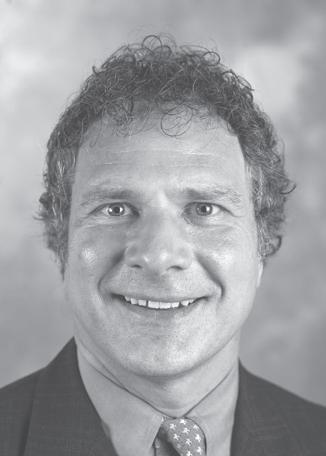
Most Interesting Client: I have had the pleasure of working with many unique clients, but LT, a 9‐year‐old girl who had a left hemispherectomy at Johns Hopkins Medical Center as a result of the effects of Rasmussen’s encephalitis, is surely one of the most unique. LT returned home after six weeks at Johns Hopkins to my care as a school‐based speech‐language pathologist. Before she returned to the school building, I visited her home with her classroom teacher to provide collaborative academic and speech‐language services. Labeling every object in her environment with print proved to be one of the most successful strategies. We encouraged LT and her family to say every word every time they used objects. On her return to school LT came to my room for the first hour of every day for individual therapy. The IEP Team prioritized speech as the most important part of her day. LT had very intact receptive language but needed to begin at the one‐word utterance level expressively. I will never forget the day she recited the entire poem “Star Light Star Bright” using words and rebus pictures. The rhythm in rhymes, poems, and songs made it easy for her brain to recite those artifacts of literacy. Spontaneous, novel utterances of increasing length came quickly; reading, however, took a bit longer but did return with the help of computerized, interactive Living Books. LT is now an adult who engages in conversation in a variety of situations with great facility after many years of therapy with several dedicated school‐based speech‐language pathologists.
Key processes in spoken communication
how Does Communication relate to Language, Speech, and hearing?
Language, speech, and hearing are the essential ingredients of human communication. The sophisticated use of these three processes for communication is what makes the human species unique. This text focuses on language, speech, and hearing as key communication tools and on how difficulties in these areas can result in disorders of communication.
Language, speech, and hearing are used for the formulation, transmission, reception, and comprehension of information using spoken channels (see Figure 1.2). Language is used for formulation and comprehension. Speech is used for transmission. Hearing is used for reception. Although the terms language, speech, and communication are often used synonymously, they describe very different processes.
The term language describes the cognitive process by which we formulate ideas and thoughts. Once these ideas and thoughts have been formulated, we can communicate them orally to others through speech. We can also choose to keep these ideas and thoughts to ourselves (inner language) or to write them down (written language).
The term speech describes the neuromuscular process by which we turn language into a sound signal that is transmitted through the air (or other medium, like a telephone connection) to a receiver. Speech involves using voice and articulators (e.g., tongue, lips, palate) to make the sounds that produce words and sentences. Why do humans have speech and language? These evolved for only one purpose: to communicate. The information shared through communication is expressed in language, and speech is a primary means by which language is transmitted. Although many other species are able to communicate, only humans have speech and language. The capacities for speech and language allow humans to share remarkably complex ideas and thoughts with one another, a feat that is not possible for other species.
FORMULATION
Put thoughts and ideas into words to share with others.
TRANSMISSION
Fluently express thoughts and ideas to others.
RECEPTION
Receive the communication sent by another person.
COMPREHENSION
Interpret the communication sent by another person.
Figure 1.2
Language
DeFInItIon Language is a socially shared code that uses a conventional system of arbitrary symbols, including words and sounds, to represent ideas about the world to others. The key elements of this definition are described below.
1. Language is socially shared: A community of speakers shares the same system for communicating their ideas. For example, everyone reading this text shares the English language as a means for communicating ideas about communication sciences and disorders.
2. Language is a code: Ideas about the world are communicated using a set of symbols. The symbols used in language are words, which are made up of sounds that are combined in various ways. The code for what you are holding in your hand right now involves three sounds—b + oo + k—blended together to form a word (book). Those of us who speak English and therefore know this particular code are a linguistic community. The word itself (in this case, book) is completely arbitrary; the thing in your hand could just as well be called a trift, formed by blending five sounds—t + r + i + f + t.
Other species are able to communicate, but only humans have the capacity for speech and language.
3. Language is a conventional system: Language follows specific, systematic conventions; it is a rule‐governed code. Strict rules govern the way a linguistic community organizes words into sentences and the way sounds are combined to make words. The rules of English constrain English speakers from saying things like Sat cat the the on hat, He drankeding the milk, and Thit rinches shug gfmiiikn nink. When someone in our linguistic community violates the community’s linguistic rules, we tend to be aware of it. For instance, if a doctor said to you, “Need prescription store go,” you would be aware that some linguistic rules were being violated. If a young child said, “He goed to the store,” you would also probably recognize that a rule was being violated, but you would be more accepting, knowing that the child was still learning the rules of language and would shortly figure out that the past tense of go is went.
4. Language is a representational tool: Language allows us to represent our thoughts and ideas to others. Language is a tool for communication, and the only reason humans evolved language was to communicate with one another. In addition to allowing us to represent our ideas, language enables our brains to store information and to carry out many cognitive processes, such as reasoning, hypothesizing, and planning (Bickerton, 1995). Although the relationship between thought and language continues to spur controversy (Can we think without using language?), we do know that much of human thought uses the code of language.
reMarkaBLe FeatureS oF Language Language is undoubtedly one of the most remarkable capacities of the human species. It is what makes us human and what makes us different from other species. Language is studied by more disciplines than any other subject. It commands the interest of psychologists, speech‐language pathologists, audiologists, linguists, sociologists, philosophers, biologists, anthropologists, educators, special educators, neuroscientists, nurses, physicians, mathematicians, and musicians, among others. A few of the remarkable features of
language that attract scholars include its universality, species specificity, productivity, and rate of acquisition.
Universality. Language is ubiquitous. Every human culture has one and sometimes many languages, and all languages are equally complex. The universality of language, as Steven Pinker wrote in The Language Instinct (Pinker, 1994, p. 26), fills linguists with awe, and is the first reason to suspect that language is not just any cultural invention but the product of a special human instinct. . . . Cultural inventions vary widely in their sophistication from society to society. . . . Language, however, ruins this correlation. There are Stone Age societies, but there is no such thing as a Stone Age language.
Species Specificity. Language is a human capacity, and no other animals share this aptitude. The species specificity of language refers to the fact that although many nonhuman species are able to communicate, their communication abilities are wholly iconic (Bickerton, 1995). Iconic communication systems are those in which there is a transparent relation between what is being communicated and how it is being communicated. For instance, the purring of a cat is a fairly transparent way to say “I like being petted.” If the purring goes up a notch to a veritable roar, it says, “I really like being petted. Keep it up.” All nonhuman communication systems are more or less iconic, whereas there is little that is iconic about human language.
Productivity. Productivity is the principal feature of combination—specifically, the combination of a small number of discrete units into seemingly infinite novel creations. Productivity applies to other human activities—such as mathematics and music—as well as to language. With a relatively small set of rules governing language, humans are capable of producing an endless number of ideas and new constructions. For instance, humans use only a small set of sounds (for speakers of Standard American English [SAE], there are about 40), and we can combine these units on the basis of a set of rules we intuitively know (e.g., /g/ does not typically follow /l/) into an almost infinite number of words and syllables. Similarly, with a relatively small number of words, humans are capable of creating an almost infinite variety of sentences, the majority of which no one has ever heard before. If you desired, right now, you could produce a sentence that no person has ever uttered before because of the remarkable productivity of language.
This productivity is inherent to language in its earliest stages of acquisition. Children who are 18 months of age and have about 50 words in their vocabulary begin to combine this small set of words to produce sentences that express a range of needs. The productivity feature of language is unique to humans, as the units of nonhuman communication systems cannot be recombined to make new meanings. For instance, night monkeys have 16 communication units. These 16 units cannot be recombined to make more than 16 possible ways to communicate, as productivity does not operate in nonhuman communication (Bickerton, 1995).
Rate of Acquisition. Noted psychologist Erika Hoff once pointed out that language development “reveals the genius in all children . . . . It is remarkable that 3‐year‐olds who can’t tie their shoes or cross the street alone have vocabularies of thousands of words and can produce sentences with relative clauses”
(Hoff‐Ginsberg, 1997, p. 3). For many of us who are researchers of child language, this is the remarkable feature of language that drew us to the field—the sheer rate of acquisition, the marvelous feat of children in learning so much so fast. Children go from using perhaps 5 words at 12 months, to 2‐word sentences and about 50 words at 18 months, to thousands of words and complex sentences by 5 years. Spend a few minutes with a 3‐year‐old child in the next week, and it is likely that you will be amazed by the language you hear. The rate of language acquisition is a key achievement of early childhood, and many scholars view language development as fairly complete by about 5 years of age, although the system is continually refined during middle and later childhood (e.g., new words are added to the vocabulary). Thus, the first 5 years of life are a critical period for language development; after this period, the rate of language development slows, and never again will so many linguistic achievements be possible in such a short period of time.
Language Domains
Language consists of three rule‐governed domains that together reflect an integrated whole: content, form, and use. Content refers to the meaning of language— the words we use and the meaning behind them. Content is conveyed through our vocabulary system, or lexicon, as we select and organize words to express our ideas or to understand what others are saying. Form is how words, sentences, and sounds are organized and arranged to convey content. Use is how language is used functionally to meet personal and social needs.
Let’s take, for instance, the two‐word sentence spoken by 2‐year‐old Dakota: “Daddy’s cup.” This sentence can be analyzed for its content, form, and use. The content is the words Dakota selected from her vocabulary and the meaning of those words; concepts expressed here include Daddy’s ownership and an object used to hold liquid and to drink from. Form is how these concepts are conveyed by organizing sounds (eight sounds are used), by manipulating word structure (’s is added to Daddy to convey possession), and by organizing words in a particular order (cup comes after Daddy’s). Use is how the content and forms function within a social routine. In this case, Dakota says “Daddy’s cup” while pointing to a cup sitting on a table. Although there are many possible functions for Dakota’s utterance, in this case she appears simply to be commenting, possibly to initiate a conversation with her mother.
Dakota: Daddy’s cup.
Mother (Looking Up): Yes, that is Daddy’s cup.
Dakota: Mommy’s cup.
Mother: You’re right. This is my cup.
Dakota: That Mommy.
Mother: Yep, this one’s mine. Where’s your cup?
Dakota: My cup.
Content, form, and use thus constitute a three‐domain system used to represent and organize the major dimensions of language. A slightly more refined description of language dimensions includes five domains (see Figure 1.3): semantics, syntax, morphology, phonology, and pragmatics. The domains of semantics and pragmatics are synonymous with the domains of content and use, respectively. The domains of syntax, morphology, and phonology reflect three elements of form.
Language consists of five domains. As you watch this video, try to determine and identify which domains have been affected by Mr. Johnson’s hearing loss.
Figure 1.3
The domains of language
Form (syntax, morphology, phonology): how we organize sentences, words, and sounds
Content (semantics): what it is we are talking about
Language
Use (pragmatics): how language is shared with others
1. Semantics (content) refers to the rules of language governing the meaning of individual words and word combinations. For instance, we know that a culprit is someone who has done something wrong and that green and blue go together meaningfully because they are both colors. Our knowledge of semantics tells us that something is wrong with the sentence Colorless green ideas sleep furiously, a sentence produced by the linguist Noam Chomsky to differentiate semantics and syntax (Pinker, 1994).
2. Syntax (form) refers to the rules of language governing the internal organization of sentences. The sentence Colorless green ideas sleep furiously abides by conventional rules of syntax: its word order is acceptable despite its lack of meaning.
3. Morphology (form) refers to the rules of language governing the internal organization of words. Words can be morphed (manipulated) to change their meanings; for instance, ‐ed can be added to walk to show that this activity happened in the past (walked), or ‐er can be added to turn the verb walk into a noun to describe a person who is walking (walker).
4. Phonology (form) refers to the rules of language governing the sounds we use to make syllables and words. Every language has a relatively small number of sounds, called phonemes. Standard American English (SAE) uses about 40 phonemes (depending on the dialect), as shown in Figure 1.4. SAE relies on the combination of 15 vowels and 25 consonants to create some 100,000 words. Some languages use more phonemes, and others use fewer (e.g., the Lakhota language, a Sioux language, uses 34 phonemes [Rood & Taylor, 1996], many of which would be unfamiliar to speakers of Standard American English). In addition, each language has rules governing how sounds are organized in words, called phonotactics. In English, for instance, the sound /g/ never follows /s/ or /l/ at the beginning of a word.
5. Pragmatics (use) refers to the rules of language governing how language is used for social purposes. Pragmatics governs three important aspects of the social use of language: (1) using language for different purposes (communication functions), (2) organizing language for discourse (conversation; Lahey, 1988), and (3) knowing what to say and when and how to say it (social conventions). Pragmatic rules
govern linguistic, extralinguistic, and paralinguistic aspects of communication, including word choice, turn taking, posture, gestures, eye contact, proximity, pitch, loudness, and pausing.
Speech
DeFInItIon Speech is the neuromuscular process that allows humans to express language as a vocal product. In spoken communication, after our ideas have been formulated (language), they must be transmitted. Speech involves the very precise activation of muscles in three systems: respiration, phonation, and articulation. These three systems create the remarkable coordination that causes a breath of air that begins in the lungs (respiration) to travel up through the trachea, or windpipe, over the vocal cords, and into the oral and nasal cavities (phonation), and then be manipulated by the oral articulators—tongue, teeth, and jaw (articulation)—so as to come out as a series of speech sounds that another person can understand and attribute meaning to (see Figure 1.5). (A fourth system—resonance—is also very important to speech. We discuss the resonance system in depth in Chapter 12, as it is very important for understanding motor speech disorders.)
To better understand the processes involved with speech, say the word eat slowly and deliberately and think about the process as you do so. You will notice that the speech process begins with the intake of a breath, which is then exhaled; this is the basic fuel needed for all speech. The exhalation travels up from the lungs through the windpipe (trachea) and over the vocal cords (within the larynx), which begin to vibrate and create the “eeeee” sound. This “eeeee” sound is then sent into the oral cavity, which is open and marked by a big, toothy smile with the lips pulled wide. Notice that the upper and lower jaws (maxilla and mandible) are held fairly close together but are not closed; the tongue sits low in the mouth, with the tip tucked behind the lower row of teeth and the middle rounded up on the sides to touch the upper teeth. Once the “eeee” sound is in the oral cavity, a brief “ea”
Figure 1.4
The phonemes of Standard American English
D ISC u SSI on Po I nt
Language consists of five domains. Describe each one of these in your own terms and give examples.
Vowels
Figure 1.5
Systems involved in speech
Laryngopharynx
Right lung
Nasal cavity
Hard palate
Maxilla
Lips
Mandible
Epiglottis
Larynx
Trachea
Left lung
Articulation
Phonation Respiration
escapes, and then the tongue comes quickly up behind the teeth to produce the “t” sound following the “ea.”
The complete neuromuscular and neuroanatomical description of this process is provided in later chapters. For now, it is important to recognize that speech is a neuromuscular act involving precise coordination of three systems. It is also important to appreciate how highly complex speech is. As a neuromuscular activity requiring considerable accuracy and involving a number of biological systems, there are many sites of possible breakdowns. Breakdowns in these systems, if serious enough, can result in a variety of communication disorders. Go ahead and produce the word eat again; as you do so, think about each stage of the speech‐production process and consider where breakdowns might occur.

The systems used by humans for speech—respiration, phonation, and articulation—did not evolve for the purpose of speech. Rather, speech as an evolved capability superimposed itself on systems that were already in place. The structures of the respiratory and phonatory systems allow us to breathe, and the structures of the articulatory system allow us to eat and drink. Although when and how humans first began to use speech is the subject of considerable popular, philosophical, and scientific debate, it is generally accepted that speech became the mode for language expression because of its advantages over other possible modalities. Unlike gestured, signed, or written communication, speech can be used with much less constraint—it is effective in the dark, across relatively large distances.

MoDeL oF SPeeCh ProDuCtIon How a human being is able to go from an idea (“I am hungry”) to a clearly articulated spoken product (“Let’s eat!”) is a question that has yet to be fully answered. This question is interesting to scientists in diverse disciplines, because speech is one of several critical capacities that make humans human.
Figure 1.6 presents a basic model of speech production. (A model is a way to represent an incompletely understood phenomenon, based on the current best evidence bout the phenomenon.) This model shows speech
Speech and language are often confused and sometimes considered synonyms. Describe in your own words how to differentiate between speech and language.
D ISC u SSI on Po I nt
The structures of the articulatory system allow us to eat and drink.
